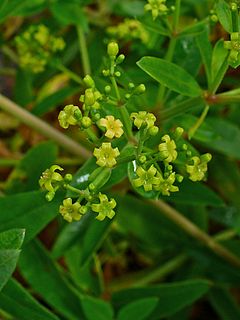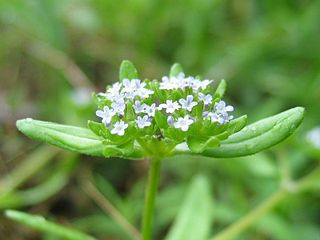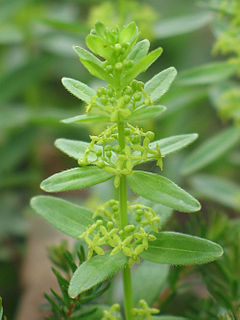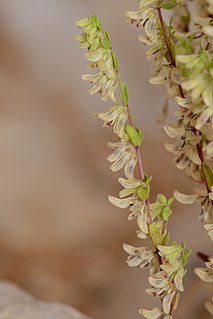
Marrubium is a genus of flowering plants in the family Lamiaceae, native to temperate regions of Europe, North Africa, and Asia as far east as the Xinjiang region of western China. A few species are also naturalized in North and South America.

Rubia is a genus of flowering plants in the family Rubiaceae. It contains around 80 species of perennial scrambling or climbing herbs and subshrubs native to the Old World. The genus and its best-known species are commonly known as madder, e.g. Rubia tinctorum, Rubia peregrina, and Rubia cordifolia.

Matthiola is a genus of flowering plant in the mustard family Brassicaceae. It is named after Italian naturalist Pietro Andrea Mattioli (1501-1577). The genus contains about 50 species of annual, biennial and perennial herbaceous plants and subshrubs. Many are cultivated for their heavily scented, colorful flowers.

The Salsoloideae are a subfamily of the Amaranthaceae, formerly in family Chenopodiaceae.

Muscari is a genus of perennial bulbous plants native to Eurasia that produce spikes of dense, most commonly blue, urn-shaped flowers resembling bunches of grapes in the spring. The common name for the genus is grape hyacinth, but they should not be confused with hyacinths. In the United States, they are also commonly referred to as bluebells, though certain regions reserve this name for bluebonnets instead. A number of species of Muscari are used as ornamental garden plants.

Asperula, commonly known as woodruff, is a genus of flowering plants in the family Rubiaceae. It contains about 195 species and has a wide distribution area from Europe, northern Africa, temperate and subtropical Asia to Australasia.

Jacobaea is a genus of flowering plants in the tribe Senecioneae and the family Asteraceae. Its members used to be placed in the genus Senecio, but have been separated into the segregate genus Jacobaea on the basis of molecular phylogenetics in order to maintain genera that are monophyletic.

Valerianella is a genus of plant in family Caprifoliaceae. Many plants of this genus are known by the common name corn salad or cornsalad, although that name most often refers to Valerianella locusta.

Bassia is a genus of flowering plants in the family Amaranthaceae. They are distributed in the western Mediterranean to eastern Asia. Some occur outside their native ranges as introduced species.

Anabasis is a genus of plants in the subfamily Salsoloideae of the family Amaranthaceae. It is distributed in southern Europe, North Africa, and Asia.

Plocama is a genus of flowering plants in the family Rubiaceae. It was described by William Aiton in 1789. It is distributed from the Canary Islands to northwestern India.

Cruciata is a genus of flowering plants in the family Rubiaceae. It is found in Europe, northern Africa, and across southern and central Asia from Turkey to the western Himalaya and north to the Altay region of Siberia.

Callipeltis is a genus of flowering plants in the family Rubiaceae. It was originally described in 1829. The genus is found in Spain, North Africa, the Middle East, the Arabian Peninsula, and Central Asia as far east as Pakistan and Kazakhstan.

Michauxia is a genus of plants in the family Campanulaceae. It contains 7 known species native to southwestern Asia.

Prangos is a genus of flowering plants of the family Apiaceae, native to the Palaearctic.
Asperula serotina is a species of flowering plant in the family Rubiaceae. It was first described in 1982 and is endemic to Turkey.

Noccaea is a problematic genus of flowering plants in the family Brassicaceae, native to temperate areas of western North America, southern South America, northern Africa, Europe and Asia.
Haplophyllum is a genus of flowering plants belonging to the family Rutaceae. It is the only genus in the subfamily Haplophylloideae.


















